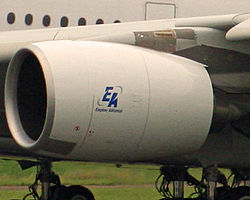Engine Alliance GP7200
| Basic data (GP7270) | |
| diameter | 316 cm |
| Fan diameter | 296 cm |
| Dimensions | 6712 kg |
| length | 474 cm |
| Technical specifications | |
|---|---|
| Bypass ratio | 9: 1 |
| Pressure ratio | 43.9: 1 |
| Air flow | 900-1200 kg / s |
| Power to weight ratio | 46.3 N / kg |
| Thrust | 311 k N (76500 lb f ) |
| Engine section | stages |
| fan | 1 |
| Low pressure compressor | 5 |
| High pressure compressor | 9 |
| High pressure turbine | 2 |
| Low pressure turbine | 6th |
The Engine Alliance GP7200 engine from the Engine Alliance is a turbofan engine . The joint venture between General Electric and Pratt & Whitney was formed in order to spread the development costs for this large turbofan jet engine across several shoulders. A380 customers with the GP7200 include Emirates , Etihad , Air France , Korean Air , Qatar and Asiana Airlines .
development
Originally intended to power the unrealized Boeing 747 X, this engine has since been used for the Airbus A380 . Pratt & Whitney developed the low-pressure system on the basis of the PW4000, including the 2.96 m diameter low-pressure compressor (fan) made of titanium , whose strikingly curved blades are visible from the front, and the low-pressure turbine. General Electric, however, developed the high pressure system (the high pressure compressor, the combustion chamber and the high pressure turbine) on the basis of the GE90 . The German company MTU Aero Engines from Munich , the French company Snecma and the Belgian Techspace Aero are also involved in the development.
The competing Rolls-Royce Trent 900 was nominated as the standard engine for the then A3XX in 1996 and was initially chosen by almost all A380 customers. However, the engine consortium of the GP72XX was able to increase its share in the sales of the A380, so that it was then used in over half of the aircraft fleet. In particular, when Emirates placed an order for 150 aircraft equipped with this engine, the imbalance was eliminated (Emirates was a traditional Rolls-Royce customer until then). All models of the A380 with this engine are numbered A380-86x, as 6 is the code for the engines of the Engine Alliance.
On December 14, 2007, the engine was officially approved by the FAA and EASA as a drive for the A380.
test
The test runs on the ground began in April 2004 and the engine was tested for the first time on August 14, 2006 on an A380. Before that, the first flight attempt took place on December 3, 2004, during which one of the four engines of a Boeing 747 was replaced by a GP7200. The engine was certified for commercial operation by the FAA on January 4, 2006 . On August 25, an A380-861 with this engine flew for the first time with the aircraft with the factory number MSN 009. The test started and ended in Toulouse and lasted about four hours. Tests were carried out for cruising speed, engine cowlings and handling. One day earlier, the engines were tested in the event of an aborted take-off using the same machine .
Other versions
The GP7277 model with 363 kN (81,500 lb f ) thrust is intended for the cargo version of the A380 at 590 tonnes all-up weight. According to Airbus, however, the development of the cargo version has been discontinued (as of April 2018).
Incidents
On September 30, 2017, on Air France Flight 66 on the way from Paris to Los Angeles, the entire fan (blades, disk and shaft parts), inlet and parts of the downstream engine casing tore off the right outer engine. No one was injured in the incident south-east of Greenland and the machine was able to land safely at the Canadian military base at Goose Bay in Newfoundland .
Web links
- www.enginealliance.com: GP7200 (updated January 15, 2019)
- EASA TCDS PDF, English, updated January 15, 2019
- aeroreport.de giant put to the test, updated on January 15, 2019
Individual evidence
- ↑ Engine breaks up on Air France A380, forcing emergency landing in Canada in the Guardian, October 1, 2017 (accessed October 1, 2017)

